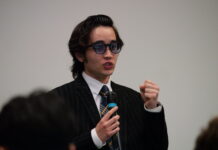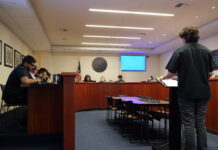
In 2007, UC Riverside associate professor of chemistry and nanotechnologist Yadong Yin discovered a way to use magnets to change the color of iron oxide solution. By adjusting the strength of a magnetic field near the mixture, he and his research team discovered that the structure of the solution will change and its color will be altered.
Five years after his discovery, Yin’s work will finally be put to practical use.
Announced on Oct. 26, UCR granted exclusive license to The Idea Zoo Inc., a company that specializes in marketing scientific innovations made by university professors. The company’s mission will be to find practical applications for Yin’s color-changing technology.
The basis of Yin’s research was to find a way to organize the structure of the iron oxide nanoparticles so that they would self-assemble into colloidal crystals to form a magnetic field. Once that was achieved, the crystals would be able to diffract visible light, producing a spectrum of colors.
“In the end we can actually use the magnetic field to control the color of the material,” Yin explained in an interview with the Highlander.
For the past few years, UCR and The Idea Zoo, Inc. have been working together to market the discovery.
“We have been working together for about three years. They do realize how much is it valued and they’re trying to push the technology through the market. It’s a dream that every researcher wants.”
As Yin put it, the research can be applied to a wide variety of color-dependent products. Since his discovery, Yin has been contacted by various industries including companies that make toys, tablets and televisions screens.
“[The technology] could be used for a lot of color related applications,” he said, voicing his excitement for the potential applications of the technology. “For example, they could be used for displays. For example, Amazon Kindle or eBook. And that’s a black and white version. If you use the photonic crystals inside, it’ll be a color version and, at the same time, you can save energy. It’s different from the LCD display because the LCD display has to constantly consume energy.”
Aside from energy saving, Yin also pointed out other improvements the technology could potentially bring.
“They are based on refraction. So the advantage is that on the sunlight, they look really shiny. It’s different from the LCD. That kind of display, when you bring it out to the sunlight, you don’t see anything. With this thing, the more sunlight, the better the contrast.”
UCR will receive royalties and equity from the products that will be developed through The Idea Zoo, Inc.
“I’m really excited,” Yin stated, “It’s amazing to see that the stuff from the lab can go to the industry.”
Yin’s contributions to his field have earned him numerous accolades and national recognition. In 2011, he was ranked one of the top 100 chemists of the decade.








